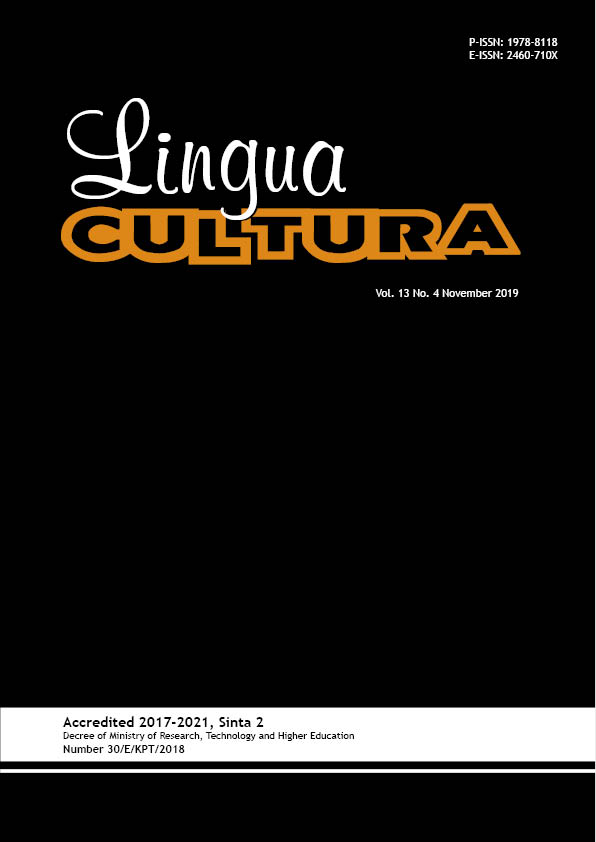Javanese Perspective of Nonverbal Language: An Ethnopragmatic Study
DOI:
https://doi.org/10.21512/lc.v13i4.6015Keywords:
nonverbal language, Javanese language, Javanese conversationAbstract
The research focused on nonverbal language (NvL) of Javanese people in Indonesia who spoke the first Javanese language and the second language Indonesian using an ethnopragmatic approach. The purpose of research was to describe the perception of the Javanese community on the use of NvL, both dynamic and static NvL. This research used a descriptive qualitative method with data collection techniques through observation of people who were communicating, interviews with resource persons, and recording as supporting techniques for data collection. Data were analyzed by steps; data identification, classification, and interpretation. The results of research have theoretical implications. If aspects of local wisdom such as those possessed by the Javanese people are preserved, it will be able to provide benefits to the preservation of culture that has been passed down through generations in Javanese society. Such conditions will be able to illustrate that the community’s perspective on Javanese culture is still well maintained from the past until now.
References
Aronson, J. (1995). A pragmatic view of thematic analysis. The Qualitative Report, 2(1), 1-3.
Barry, B. E. (2011). Student nonverbal communication in the classroom. American Society for Engineering Education, 1–14.
Bonaccio, S., O’Reilly, J., O’Sullivan, S. L., & Chiocchio, F. (2016). Nonverbal behavior and communication in the workplace: A review and an agenda for research. Journal of Management, 42(5), 1044-1074. https://doi.org/10.1177/0149206315621146.
Botting, N. (2005). Non-verbal cognitive development and language impairment. The Journal of Child Psychology and Psychiatry, 46(3), 317-326. https://doi.org/10.1111/j.1469-7610.2004.00355.x.
Brown, L. (2011). Test of nonverbal intelligence. In McCallum R.S. (Eds.), Handbook of Nonverbal Assessment (pp. 199-221). Boston: Springer. https://doi.org/10.1007/978-1-4615-0153-4_10.
Brown, G., & Yule, G. (2013). Introduction: linguistic forms and functions. In Discourse Analysis (pp. 1-26). Cambridge: Cambridge University Press. https://doi.org/10.1017/cbo9780511805226.003
Buck, R., & VanLear, C. A. (2018). Verbal and nonverbal communication: Distinguishing symbolic, spontaneous, and pseudo-spontaneous nonverbal behavior. Journal of Communication, 52(3), 522–541. https://doi.org/10.1093/joc/52.3.522.
Deda, N. (2013). The role of pragmatics in English language teaching: Pragmatic competence. Academic Journal of Interdisciplinary Studies, 2(4), 63-70. doi:10.5901/ajis.2012.v2n4p63.
Dijk, T. A. Van. (2009). Discourse and context: A sociocognitive approach. Cambridge: Cambridge University Press.
Geertz, C. (1973). The interpretation of cultures. USA: Basic Books Inc.
Kapferer, B. (1988). The Antropologist as hero: Three exponents of post-modernist anthropology. Critique of Anthropology, 8(2), 77-104. https://doi.org/10.1177/0308275X8800800206.
Lapakko, D. (2007). Communication is 93% nonverbal: An urban legend proliferates. Communication and Theater Association of Minnesota Journal, 34, 7-19.
Miller, D. (2011). A reflection on EO research and some suggestions for the future. Entrepreneurship Theory and Practice, 35(5), 873-894. https://doi.org/10.1111/j.1540-6520.2011.00457.x.
Patel, D. S. (2014). Body language: An effective communication tool. IUP Journal of English Studies, 9(2), 90–95.
Pranowo, (2016). Unsur intralingual dan ekstralingual sebagai penanda daya bahasa dan nilai rasa bahasa dalam kesantunan berkomunikasi. AdabiyyÄt: Jurnal Bahasa Dan Sastra, 14(2), 191-225. https://doi.org/10.14421/ajbs.2015.14202.
Pranowo, (2018). Basa Jawa krama alus lan santun. Yogyakarta: Dinas Kebudayaan Propinsi DIY.
Santschi, E. M., Williams, J. M., Morgan, J. W., Johnson, C. R., Bertone, A. L., Juzwiak, J. S. (2015). Preliminary investigation of the treatment of equine medial femoral condylar subchondral systic lesions with a transcondylar screw. Veterinary Surgery, 44(3), 281-288. https://doi.org/10.1111/j.1532-950X.2014.12199.x.
Spradley, J. (1979). Interviewing an informant. In The Ethnographic Interview. New York: Holt, Rinehart and Winston.
Spradley, J. (1998). The ethnographic interview. In Introduction to Qualitative Methods. New York: Holt, Rinehart and Winston.
Wang, H. (2014). Nonverbal communication and the effect on interpersonal communication. Asian Social Science, 5(11), 155–159. https://doi.org/10.5539/ass.v5n11p155.
Zhou, H. (2009). Body language in business negotiation. International Journal of Business and Management, 3(2), 90–96. https://doi.org/10.5539/ijbm.v3n2p90.
Downloads
Published
How to Cite
Issue
Section
License
Authors who publish with this journal agree to the following terms:
a. Authors retain copyright and grant the journal right of first publication with the work simultaneously licensed under a Creative Commons Attribution License - Share Alike that allows others to share the work with an acknowledgment of the work's authorship and initial publication in this journal.
b. Authors are able to enter into separate, additional contractual arrangements for the non-exclusive distribution of the journal's published version of the work (e.g., post it to an institutional repository or publish it in a book), with an acknowledgment of its initial publication in this journal.
c. Authors are permitted and encouraged to post their work online (e.g., in institutional repositories or on their website) prior to and during the submission process, as it can lead to productive exchanges, as well as earlier and greater citation of published work.
USER RIGHTS
All articles published Open Access will be immediately and permanently free for everyone to read and download. We are continuously working with our author communities to select the best choice of license options, currently being defined for this journal as follows: Creative Commons Attribution-Share Alike (CC BY-SA)


















